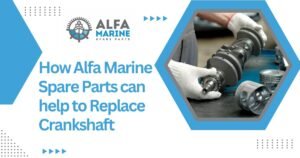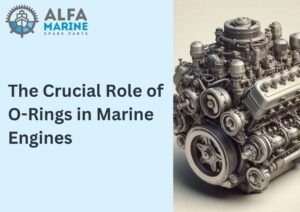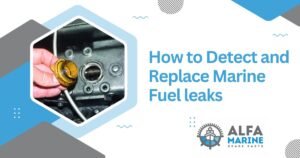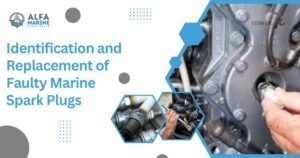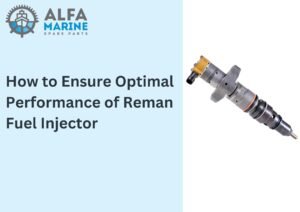The cylinder head is a crucial component of the cylinder liner in marine engines. This part a.k.a. cylinder cover is mounted on the cylinder liner situated on the upper part of the engine.
Basically, a cylinder head is made of a set of components (discussed below) to serve as a cover for the combustion chamber of the engine.
In this blog post, we are offering a guide to marine engine cylinder heads and their significance in vessel operation.
Understanding the Prime Cylinder Head Components
Understanding the Prime Cylinder Head Components” delves into the essential elements of cylinder head construction and function within internal combustion engines.
It provides insights into the critical components that comprise the cylinder head, such as the fuel injector, inlet and exhaust valves, cylinder relief valve, valve rotators, valve seats, and fuel injection valve
Fuel Injector
This is a high-precision part with a spring-loaded needle valve attached to the fuel pump plunger. Upon receiving pressurized fuel from the pump, the rises to build up pressure in the chamber. The action induces the needle valve to open and induce fuel at a high pressure and speed to the combustion chamber.
Inlet and Exhaust Valves
The inlet valves of marine cylinder heads are made of chrome, silicon, and steel alloy to support low temperatures. This is not the same for exhaust valves featuring chrome, nichrome, and silicon-chromium/ cobalt chromium alloy composition for supreme resilience to bear extremely high temperature, pressure, and stress.
Cylinder Relief Valve
This valve releases excess pressure from the combustion chamber. When the pressure in the combustion area exceeds 10-20% of the normal pressure, the valve opens to relieve the stress from the unit.
Recommended Read: Cylinder Relief Valve in Marine Engines Explained
Valve Rotators/ Spinners
The valve rotators regulate a spinning action to eliminate the carbon deposits on the valve seat. Besides controlling emissions, it is a safety device to prevent fire break out on the valve seat and face.
Valve Seats
A valve seat is a ring-like structure to support firm closure between the seal and the intake and exhaust valves when the engine is not running.
Inlet and Exhaust Valve Inserts
Each cylinder head comprises a set of two inlet valves and a couple of exhaust valves. The inlet valve inserts offer a passage for the pressurized fuel-air mixture into the combustion chamber. The exhaust valve inserts create an opening to release the burnt gases from the combustion chamber.
Fuel Injection Valve
A fuel injection valve is housed on the interchangeable sleeve located at the center of the cylinder head. It creates a safe passage for the injector to spray high-pressure air and fuel mixture in a mist form into the cylinder of the engine.
Functions of Cylinder Heads in Marine Engines
A cylinder head performs multiple functions to regulate the engine operations seamlessly.
First, it serves as a sealant closure for the combustion chamber of the engine cylinder.
Second, it supplies combustion forces (fuel-air mixes) into the combustion area.
Third, the cylinder head creates a passage for the exhaust gases and soot to escape from the combustion chamber.
Fourth, it has an opening to supply cooling water to the exhaust valve coming from the liner.
Signs of Marine Cylinder Head Failure
When a marine engine is leaking or overheating, the problem may be a cylinder head failure. Here are a few instances and signs to know, it is time to repair or replace the faulty cylinder head.
Excessive smoke released from the exhaust
Overheating in the internal combustion engine parts
Receding engine efficiency and performance
Oil leakage with deposits on the cylinder head
Reduced coolant in the engine
How to clean a cylinder head?
Cleaning a cylinder head involves several steps to ensure thorough removal of dirt, debris, and carbon deposits. Here’s a general guide on how to clean a cylinder head:
Preparation
- Ensure the cylinder head is removed from the engine and placed on a clean, flat surface.
- Wear appropriate safety gear, including gloves and eye protection.
Initial Inspection
- Proceeding with cleaning. Examine the cylinder head for any signs of damage, cracks, or warping. Address any issues before pr
Degreasing
- Use a degreaser or engine cleaner to remove oil, grease, and dirt from the cylinder head surfaces.
- Apply the degreaser generously and scrub the surfaces with a brush to loosen stubborn deposits.
Soaking
- For heavily soiled cylinder heads, consider soaking them in a degreaser solution overnight to facilitate the removal of built-up deposits.
Rinsing
- Thoroughly rinse the cylinder head with water to remove the degreaser and loosened debris.
- Use a pressure washer or hose with moderate pressure to ensure complete removal of residues.
Cleaning Passages and Ports
- Use compressed air or a specialized cleaning brush to clean out passages, ports, and coolant galleries in the cylinder head.
- Ensure these passages are completely clear of debris to maintain proper coolant flow and engine function.
Removing Carbon Deposits
- If necessary, use a wire brush or scraper to remove stubborn carbon deposits from blazing chambers and valve seats.
- Be cautious not to damage the surface finish or critical sealing areas of the cylinder head.
Final Inspection
- After cleaning, inspect the cylinder head again for any remaining debris or signs of damage.
- Ensure all surfaces are clean and free from contaminants before reinstallation.
Drying
- Allow the cylinder head to air dry completely or use compressed air to remove any remaining soggy.
Protection
- Apply a light coat of oil or rust inhibitor to protect the cleaned surfaces from corrosion during storage or before reinstallation.
By following these steps, you can effectively clean a cylinder head and ensure optimal engine performance.
If you’re unsure about any aspect of the cleaning process, consult a professional mechanic or engine specialist for guidance.
Final Thought
Are you looking for genuine spare parts for cylinders?
Alfa Marine Spare Parts is the leading online store for reliable high-quality marine engines, spare parts, and ship accessories. Contact us with the required part number. Our knowledgeable sales executives send a quote within 24 hours and ensure fast shipping.


